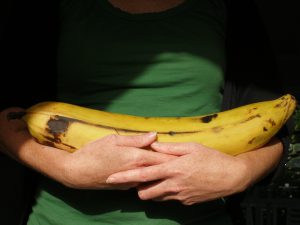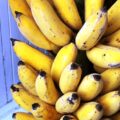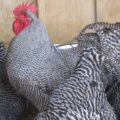
Virgil Evetts
I just had to share this picture. You are looking at one obscenely large plantain (starchy cooking banana), given to me last week by someone who takes pleasure in surprising me with strange fruit. Apparently it’s peak banana season in the tropical Pacific right now, and a Samoan friend, who has reached the point of what she describes as ‘annual banana saturation,’ has been using her surplus glut to educate me on this clan of fruits’ many uses in Samoan cooking. She burst into my office one morning last week brandishing this monstrosity – which caused quite a stir amongst my colleagues (including, I might add, some rather childish tittering).
In its unripe, starchy form, this variety of plantain is most popularly cooked with coconut milk and onions. I can testify first hand that however basic this may sound, it’s an excellent dish – if a touch too heavy for my everyday tastes. I’m assured that’s it’s even better with the addition of tinned tuna (my most despised of all food-stuffs). No thank you. Given time and neglect the fruit ripens to a pink-fleshed, sickly-sweet giant, with enough sugar and fibre to induce dual bouts of diarrhoea and diabetes.
While we’re on the subject, I am currently working my way through my very first crop of home-grown bananas, and they are now officially my favourite backyard fruit. I’m growing a hardy Samoan variety called Misi luki, which produces huge bunches of richly-flavoured, sugar-sweet ladyfinger-type bananas. The sticky sweetness of the flesh is nicely off-set by a slight edge of acidity, a quality so often missing from-ho-hum shop-bought bananas.
Much of the North Island is suitable for growing bananas (and possibly a few pockets of the South Island too), and the plants, with their great, flapping green leaves, bring a real tropical ambiance to the garden. Russell Franshams’ Subtropicals Nursery in Matapouri offers an excellent selection of banana cultivars to choose from, and he’s happy to ship nationwide.
I’m always on the lookout for new backyard crops – what’s your favourite?






Thank You for Sharing this informative article! It is very useful to everyone Stay healthy and keep safe!
Where can you find Plantain in New Zealand to buy? Especially Auckland? I’m from Jamaica and living here and we always cook plantain. It’s a part of many of our dishes. I’ve really been looking for it but no luck. Any help would be great.
We are in north Canterbury! The label says “Cara Cara. Blood Navel Orange. A mid-season, low acid and vitually seedless Blood Navel Orange, Cara Cara’s raspberry-coloured flesh is sweet to taste, with subtle cherry overtones and extremely juicy. Ideal for use in cooked sauces.”
If I can grow them here, you should be able to. I only bought and planted the tree this spring. The day after I planted it, we had a full on Nor-wester and all the growing tips got burnt! So I’ve made a bamboo wall to shelter it from two sides and it’s sheltered on the other side by the house.
Watering it every dry day (it’s next door to the veg patch) and the growing tips have grown back, plus there’s a plethora of flower buds forming.
I also want to know about blood oranges – I would love a tree or two.
I must say that my Tahitian limes are my pride and joy. we have 4 trees and being able to send boxes of limes to friends in Wanaka mid winter is very rewarding.a
PS I also love my quince, fig and feijoas.
Blood oranges are wonderful fruit- out of interest, where in NZ are you and what variety of blood orange are you growing?
I know it’s not new or exciting, but you can never have enough strawberries!
Other than that, I’ve recently planted a blood orange bush, taking care to shelter it from the fearsome winds we sometimes get, and the flowerbuds are starting to form. Looking forward to home grown blood oranges!
I am very basic but the one I use the most is my Tahitian Lime. I also have a grapefruit and a mandarin.
In terms of other things I love having silver beet, rhubarb and rocket, all so easy care and useful.
Sounds like you might be better to hack it out and start again with a named variety, Lorna. My misi luki is nothing like that! It’s true that you need to cut down the whole plant when it has fruited. Each ‘tree’ (really just a stem) can only fruit once and will be replaced by a pup from the previous season. Unless cut down, the stems persist- for years sometimes- and eventually form impenetrable, unfruitful thickets.
I have a banana tree growing in the backyard but it only produced two bunches very small, stubby ladyfingers, all of which had black, hard stripes of skin that grew into the banana flesh. Or was it hard black stripes that grew out of the flesh into the skin? They weren’t very nice, anyway. I understand that once the tree has fruited, you’re supposed to cut down that trunk and allow a new one to grow up for the next season, but I haven’t done that. It’s quite tatty looking and has several trunks growing either side of the fence between me and my neighbour. I’m not even sure whose tree it is, theirs or mine.